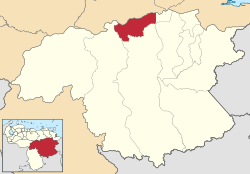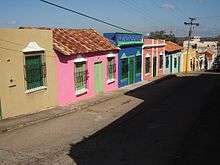Ciudad Bolívar
| Ciudad Bolívar | ||||||||
|---|---|---|---|---|---|---|---|---|
| City of Venezuela | ||||||||
| Ciudad Bolívar | ||||||||
| ||||||||
| ||||||||
|
Nickname(s): La puerta del sur de Venezuela (English:"The gate to southern Venezuela") | ||||||||
|
Motto: No encontrarás otra de más variada riqueza (English:"You won't find another with such a variety of wealth")[1] | ||||||||
 Heres Municipality in Bolívar State | ||||||||
| Country | Venezuela | |||||||
| State | Bolívar | |||||||
| Municipality | Heres | |||||||
| Founded | 22 May 1764 | |||||||
| Government | ||||||||
| • Mayor | Sergio Hernández (PSUV)[1][2] | |||||||
| Area | ||||||||
| • Total | 209,52 km2 (8,090 sq mi) | |||||||
| Elevation | 54 m (177 ft) | |||||||
| Population (380.953) | ||||||||
| • Total | 350,691 | |||||||
| • Density | 1,633.63/km2 (4,231.1/sq mi) | |||||||
| • Demonym | Bolivarense | |||||||
| Time zone | VST (UTC– 4:30) | |||||||
| Postal code | 8001 | |||||||
| Area code(s) | 0285 | |||||||
| Website | Official Site. | |||||||
| The area and population figures are for the city. | ||||||||
Ciudad Bolívar (Spanish pronunciation: [sjuˈðað βoˈliβar]; Spanish for "Bolivar City"), formerly known as Angostura, is the capital of Venezuela's southeastern Bolívar State. It lies at the spot where the Orinoco River narrows to about 1 mile (1.6 km) in width, is the site of the first bridge across the river, and is a major riverport for the eastern regions of Venezuela.
Historic Angostura gave its name to the Congress of Angostura, to the Angostura tree, and to Angostura bitters. Modern Ciudad Bolívar has a well-preserved historic center; a cathedral and other original colonial buildings surround the Plaza Bolívar.
History
The city was founded in 1764 as San Tomas de la Nueva Guayana[3] or Santo Tomé de Guayana de Angostura del Orinoco, named in honor of its diocese and for its position at the first narrows of the Orinoco River. Ciudad Bolívar was the site of the Congress of Angostura from 1819 to 1821. It was responsible for the creation of Gran Colombia in its first year of operation.[3] Angostura bitters were invented in the city in 1824, although the company which produced them later moved to Trinidad and Tobago.[4]
The city was renamed in honor of Simon Bolivar in 1846.
The Venezuelan artist Jesús Rafael Soto was a native of the city. The Jesús Soto Museum of Modern Art, named in his honor and designed by Venezuelan architect Carlos Raúl Villanueva, was opened in 1973.
Law and government
Ciudad Bolívar's municipal government is led by the mayor. Its local legislature is the Municipal Council, made up of seven councillors. A municipal comptroller oversees the public finances, and the Local Public Planning Council manages the municipality's development.[5]
Vegetation
Moriche palms and scrub oaks are found on the shores of the river. Species including the carob tree, the sarrapia, and the merecure are prevalent. Local fauna include capybaras, turtles, herons, parrots, limpets, and iguanas, and others. Fish in the area include Salminus and Palometa.
Climate
Under the Köppen climate classification, Ciudad Bolívar has a tropical savanna climate (Aw) with distinctive dry and wet seasons. The average temperature is 28.5 °C (83.3 °F) which remains fairly constant throughout the year, varying between 27.6 °C (81.7 °F) in January to 28.9 °C (84.0 °F) in October. The dry season, which runs from December to April has little precipitation during these months and temperatures tend to be cooler than the wet season but still hot, regularly reaching 32 °C (90 °F) during the day and dropping to 22 °C (72 °F) during the night. The wet season which runs from May to early November sees and increase in precipitation levels although days without any precipitation are common. Temperatures tend to be slightly warmer than the dry season. On average, Ciudad Bolívar receives 977 mm (38.5 in) of precipitation per year and there are 89.3 days with measureable rainfall. The city is fairly sunny, averaging almost 2900 hours of bright sunshine or an average of 7.9 hours of sunshine per day, ranging from a high of 260.4 hours in October (8.4 hours of sunshine per day) to a low of 201.0 hours in June (or 6.7 hours of sunshine per day).[6]
| Month | Jan | Feb | Mar | Apr | May | Jun | Jul | Aug | Sep | Oct | Nov | Dec | Year |
|---|---|---|---|---|---|---|---|---|---|---|---|---|---|
| Record high °C (°F) | 37.1 (98.8) |
39.8 (103.6) |
39.2 (102.6) |
39.7 (103.5) |
40.4 (104.7) |
37.4 (99.3) |
37.3 (99.1) |
37.6 (99.7) |
38.0 (100.4) |
37.9 (100.2) |
38.2 (100.8) |
37.6 (99.7) |
40.4 (104.7) |
| Average high °C (°F) | 32.3 (90.1) |
33.2 (91.8) |
34.3 (93.7) |
35.0 (95) |
34.4 (93.9) |
32.7 (90.9) |
32.4 (90.3) |
32.9 (91.2) |
33.6 (92.5) |
33.6 (92.5) |
33.4 (92.1) |
32.5 (90.5) |
33.4 (92.1) |
| Daily mean °C (°F) | 27.6 (81.7) |
28.0 (82.4) |
28.9 (84) |
29.5 (85.1) |
29.4 (84.9) |
28.2 (82.8) |
27.9 (82.2) |
28.4 (83.1) |
28.8 (83.8) |
28.9 (84) |
28.8 (83.8) |
28.0 (82.4) |
28.5 (83.3) |
| Average low °C (°F) | 22.8 (73) |
22.7 (72.9) |
23.5 (74.3) |
24.0 (75.2) |
24.3 (75.7) |
23.7 (74.7) |
23.4 (74.1) |
23.8 (74.8) |
24.0 (75.2) |
24.1 (75.4) |
24.1 (75.4) |
23.4 (74.1) |
23.7 (74.7) |
| Record low °C (°F) | 17.9 (64.2) |
18.1 (64.6) |
20.0 (68) |
18.6 (65.5) |
17.7 (63.9) |
18.2 (64.8) |
18.2 (64.8) |
17.8 (64) |
18.0 (64.4) |
18.5 (65.3) |
19.2 (66.6) |
18.0 (64.4) |
17.7 (63.9) |
| Average rainfall mm (inches) | 21.7 (0.854) |
13.3 (0.524) |
8.9 (0.35) |
26.8 (1.055) |
102.3 (4.028) |
165.1 (6.5) |
183.2 (7.213) |
160.1 (6.303) |
95.7 (3.768) |
97.3 (3.831) |
61.7 (2.429) |
40.9 (1.61) |
977.0 (38.465) |
| Average rainy days (≥ 1.0 mm) | 3.9 | 2.3 | 1.6 | 2.4 | 9.0 | 15.3 | 14.9 | 11.8 | 8.2 | 7.4 | 6.2 | 6.3 | 89.3 |
| Average relative humidity (%) | 69.5 | 67.5 | 66.0 | 66.5 | 69.5 | 73.5 | 73.5 | 72.5 | 70.5 | 71.0 | 71.5 | 72.0 | 70.2 |
| Mean monthly sunshine hours | 248.0 | 235.2 | 263.5 | 234.0 | 226.3 | 201.0 | 232.5 | 248.0 | 252.0 | 260.4 | 249.0 | 244.9 | 2,894.8 |
| Source #1: Instituto Nacional de Meteorología e Hidrología (INAMEH)[7][8] | |||||||||||||
| Source #2: NOAA (extremes, sun, precipitation days 1961–1990),[6] World Meteorological Organization (precipitation, 1961–1990)[9] | |||||||||||||
Economy
The Bolívar state economy is dominated by agriculture and animal husbandry, particularly cattle and pigs. Agricultural products of the area include maize, cassava, mango, yam, and watermelon. Tourism has become increasingly important to the area.
Local mass media include the television stations Bolívar Visión and TV Río, and newspapers El Bolivarense, El Expreso, El Progreso, and El Luchador.
Education
Universidad de Oriente
Universidad de Oriente (UDO) Núcleo de Bolívar, is the main public institution located in Ciudad Bolivar and in other cities of eastern Venezuela. On 20 February 1960, by resolution of the University Council, is created the Bolívar Nucleus, since that is become the most important university in the country South-Eastern.

Today, this UDO nucleus has a Basic Courses School, Health Sciences School "Dr. Francisco Battistini Casalta" and Earth Sciences School, undergraduate degrees in Industrial Engineering, Geological Engineering, Civil Engineering, Mining Engineering, Geology, Medicine, Nursing and Bioanalysis.[10]
Universidad Nacional Experimental de Guayana

Universidad Nacional Experimental de Guayana (UNEG) is another public institution in Ciudad Bolívar, founded 9 March 1982 by resolution N° 1.432 of President Luis Herrera Campins. This university was conceived as a center of superior education regional.
The original name of the university project was South University the Dr. Carlos Grüber Hernández (1931–2007) cas one of the pioneers in the fight for the University of South, he was the Founder President of the University of Southern Pro Guiana Committee.[11]
The UNEG Ciudad Bolívar offers undergraduate degrees in Administration and accounting, Education and Tourism.
Other universities
- Universidad Simón Rodríguez.
- Universidad Gran Mariscal de Ayacucho.
- Instituto Universitario Tecnológico del Estado Bolívar.
- Universidad Nacional Abierta.
- Instituto Universitario Tecnológico Rodolfo Loero Arismendi.
- Universidad Bolivariana de Venezuela.
- Instituto Universitario de Tecnológia Antonio José de Sucre.
- Universidad Nacional Experimental Politécnica de la Fuerza Armada Nacional.
- Universidad Pedagógica Experimental Libertador.
- Universidad Central de Venezuela (UCV) – Centro Regional Ciudad Bolívar
Culture


Ciudad Bolívar's historic district is a popular tourist attraction, featuring houses and buildings that date from the colonial period. The Jesús Soto Museum of Modern Art—named after the city's native sculptor and painter Jesús Soto—features a collection of modern works by Venezuelan and international artists. Ciudad Bolívar is also the birthplace of musicians Cheo Hurtado, Iván Pérez Rossi and Antonio Lauro, and the home of the musical group Serenata Guayanesa.
Traditional local cuisine includes desserts and preserves made of cashew nuts, eaten alone or roasted with salt. The cassava bread prepared in the area is well known, as well as several meals made of tortoise meat such as the Carapacho de Morrocoy Guayanés (baked tortoise in its shell). Locals also use the juice of cassava to create the spicy Catara sauce, an alleged aphrodisiac.
Transportation

Buses are the main means of public transport in the city.
The José Tomás de Heres Airport is located in the center of the city.
The Angostura Bridge connects the city to the rest of Venezuela. The freeway that connects Ciudad Bolívar with Ciudad Guayana is a major regional road.
Notable People
Victor Martinez (baseball): First Baseman/Catcher/Designated Hitter for the Detroit Tigers of Major League Baseball
See also
References
Citations
- 1 2 http://www.alcaldiaheres.com/
- ↑ Partido Socialista Unido de Venezuela
- 1 2 EB (1878).
- ↑ Loeb, Katie M. (2012). Shake, Stir, Pour: Fresh Homegrown Cocktails. Beverly, MA: Quarry Books. p. 146. ISBN 9781592537976. OCLC 806490659.
- ↑ Law and government Archived 15 November 2006 at the Wayback Machine
- 1 2 "Ciudad Bolivar Climate Normals 1961–1990". National Oceanic and Atmospheric Administration. Retrieved 2 March 2013.
- ↑ "Estadísticos Básicos Temperaturas y Humedades Relativas Máximas y Mínimas Medias" (pdf). INAMEH (in Spanish). Retrieved 2 March 2013.
- ↑ "Estadísticos Básicos Temperaturas y Humedades Relativas Medias" (pdf). INAMEH (in Spanish). Retrieved 2 March 2013.
- ↑ "World Weathr Information Service – Cd. Bolivar". World Meteorological Organization. Retrieved 2 March 2013.
- ↑ http://www.bolivar.udo.edu.ve/index.php/component/content/article?id=71
- ↑ El Expreso Foro de los Lunes "Anhelo de la Colectividad. Creación de la Universidad de Guayana" pag.3 Ciudad Bolívar 17 December 1979
Bibliography
- "Encyclopædia Britannica", Encyclopædia Britannica, 9th ed., Vol. II, New York: Charles Scribner's Sons, 1878, p. 45.
External links
| Wikimedia Commons has media related to Ciudad Bolívar. |
 Ciudad Bolívar travel guide from Wikivoyage
Ciudad Bolívar travel guide from Wikivoyage- Bolívar's message to the Congress of Angostura
- Ciudad Bolívar at Venezuelatuya.com (Spanish)
- Images of Ciudad Bolívar (Spanish)
| |||||||||||||||||||





.png)